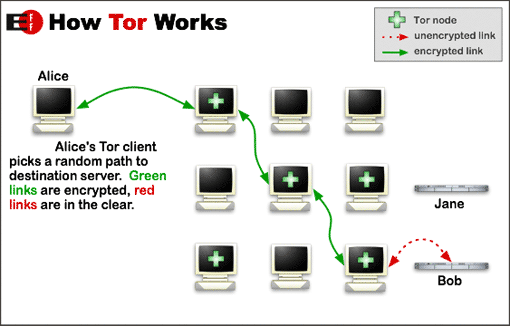Posts Tagged tor
The Onion Router (TOR)
Posted by taolu in Existing Similar Tools on April 18, 2012
 Tor is a system intended to enable on-line anonymity, originally designed, implemented, and deployed as a third-generation onion routing project of the U.S. Naval Research Laboratory. It was originally developed with the U.S. Navy in mind, for the primary purpose of protecting government communications. Now tor has been used every day for a wide variety of purposes by normal people, the military, journalists, law enforcement officers, activists, and many others.
Tor is a system intended to enable on-line anonymity, originally designed, implemented, and deployed as a third-generation onion routing project of the U.S. Naval Research Laboratory. It was originally developed with the U.S. Navy in mind, for the primary purpose of protecting government communications. Now tor has been used every day for a wide variety of purposes by normal people, the military, journalists, law enforcement officers, activists, and many others.

Tor helps to reduce the risks of both simple and sophisticated traffic analysis by distributing your transactions over several places on the Internet, so no single point can link you to your destination. The idea is similar to using a twisty, hard-to-follow route in order to throw off somebody who is tailing you — and then periodically erasing your footprints. Instead of taking a direct route from source to destination, data packets on the Tor network take a random pathway through several relays that cover your tracks so no observer at any single point can tell where the data came from or where it’s going.
To create a private network pathway with Tor, the user’s software or client incrementally builds a circuit of encrypted connections through relays on the network. The circuit is extended one hop at a time, and each relay along the way knows only which relay gave it data and which relay it is giving data to. No individual relay ever knows the complete path that a data packet has taken. The client negotiates a separate set of encryption keys for each hop along the circuit to ensure that each hop can’t trace these connections as they pass through. Once a circuit has been established, many kinds of data can be exchanged and several different sorts of software applications can be deployed over the Tor network. Because each relay sees no more than one hop in the circuit, neither an eavesdropper nor a compromised relay can use traffic analysis to link the connection’s source and destination. Tor only works for TCP streams and can be used by any application with SOCKS support. For efficiency, the Tor software uses the same circuit for connections that happen within the same ten minutes or so. Later requests are given a new circuit, to keep people from linking your earlier actions to the new ones.
Tor can’t solve all anonymity problems. It focuses only on protecting the transport of data. You need to use protocol-specific support software if you don’t want the sites you visit to see your identifying information. Tor does not provide protection against end-to-end timing attacks: If an attacker can watch the traffic coming out of your computer, and also the traffic arriving at your chosen destination, he can use statistical analysis to discover that they are part of the same circuit.
This summary was written using the following sources:
[1] Tor Homepage
[2] Wikipedia about Tor
[3] Tor wiki